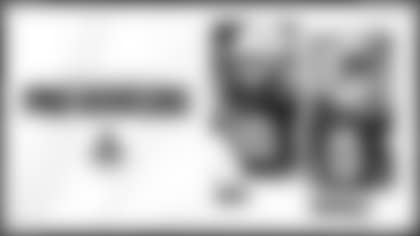The Patriots offense with rookie quarterback Bailey Zappe has lit up two below-average defenses, and that's nothing to sniff at in any regard.
Since Zappe began starting games for the injured Mac Jones, the Patriots offense is fifth in expected points added per play (+0.17). Among 36 quarterbacks with a minimum of 85 drop-backs this season, Zappe is fifth in EPA per play (+0.19) and leads all passers in completion percentage over expectation (aka CPOE: +8.9).
The overall efficiency and mostly turnover-free production by the Patriots offense with Zappe under center is eye-opening. But to have an honest conversation about Zappe playing over a healthy Jones, we need to put his two starts in proper context in a fair and balanced way.
According to Football Outsiders' DVOA metric, Zappe's two starts came against the 30th-ranked Browns defense (down Clowney and Ward) and a Lions defense (without two starting DBs) that ranks dead-last in DVOA. In other words, two of the worst defenses in the NFL this season. According to Pro Football Focus, Zappe has yet to hit a "big-time throw" downfield. He's also averaging just 6.7 air yards per pass attempt, and 31.6% of his drop-backs involve play-action.
Clearly, Zappe can hit open receivers in an NFL game, generate explosive plays off play-action, and function inside the structure of New England's system. The numbers speak for themselves.
The bottom line is this: can Zappe still outperform Mac when the situation around him isn't doing the heavy lifting and receivers aren't consistently getting open?
Can he make things happen on his own? Can he complete throws when better defenses have tighter coverage on New England's receivers? What happens when the play-calling and schemes aren't as successful as teams begin to game-plan him? It won't always be this easy.
With that said, Zappe fever is real. Coming from someone who was as reluctant as anyone to embrace the Zappster, I'm all in. His field vision, ability to take advantage of a defense's mistakes, and processing speed are excellent. Some of this mental stuff is not normal, and his accuracy and velocity downfield are good enough to succeed at this level.
The biggest difference between the Zappe system and the Mac playbook is how often the offense has been under center and how frequently the Patriots have used play-action passes.
In the first three weeks of the season with Mac, Jones only had 11 drop-backs from under center (ten percent), and the Patriots only dialed up play-action on 10.8 percent of his throws. With Zappe, the rookie was under center on over 21% of his drop-backs with a play-action rate of 31.6. Overall, Zappe has been under-center on 48.8% of all plays, including runs, while Jones was only under center on 28.1% of his snaps.
In the win over the Browns, Zappe averaged a ridiculous 20.6 yards on eight play-action attempts. Above, you see the formula. Eight in the protection, a clear-out route taking the deep safety upfield, Zappe playing cat-and-mouse with the single-high safety (looks him off), and Jakobi Meyers getting wide open on a "read it" downfield option route for a chunk gain.
To make a case for Zappe, there were instances where he had to operate in a tougher environment and did so successfully. He was also under pressure at a much higher clip this week (36.1% of drop-backs) and handled both four-man and blitz pressure well.
These quarterback plays start to make you feel things with Zappe. The Pats are again running the downfield option route (crosser or out) against a single-high safety structure, cover-three off play-action.
With the clear-out route keeping the deep safety over the top, the MIKE linebacker uses a "robot" technique to turn his back to the line of scrimmage and run underneath the crosser (Thornton). Zappe steps up in the pocket to keep himself clean with the edge pressure closing in, buys enough time for Thornton to get onto the other side of the linebacker (#50), and throws a catchable pass for a 21-yard gain.
The first-year quarterback has been exceptional operating from under center off play-action. But it's far from the only thing he did well on Sunday, as he also read out full-field progressions.
On the first touchdown connection between a pair of Pats rookies since 1993, Zappe's processing speed to come off his initial read fast enough to hit his next read was on full display.
New England gets man coverage on the goal line from the Browns that is confirmed when DeVante Parker is followed in motion. The Pats have a pick play on with Hunter Henry setting the pick for Meyers in the flat, but it doesn't work. The Browns do a good job of taking it away, and Zappe comes off it quickly and gets to the double slants on the back side. With Thornton winning on his route, Zappe puts it on him for six.
Here's another example where Zappe comes off a covered initial read and gets to his check down. This time, the three-receiver combination to his left is not the cleanest rep by his pass-catchers. Sensing pressure in the pocket, he buys time and gets to his check down, where Rhamondre Stevenson creates enough space to move the sticks on third down.
We'll continue to stress that you can't judge Zappe's long-term outlook based solely on one game. But his downfield reads and internal clock, which were issues we pointed out in his first two appearances, are improving as he sees more live game reps.
Only the coaching staff can determine if this is a one-start flash in the pan or indicative of something Zappe can consistently do each week. And that's why it's an impossible decision to bench Jones after a successful rookie season and flashes to begin year two over one game.
We'll leave that unenviable position up to head coach Bill Belichick and staff and stick to what we know: Zappe played an exceptional game against the Browns.
Here are three more takeaways and quick-hit notes from Patriots-Browns after further review:
1. Coaches Film Deep-Dive Into Rookie WR Tyquan Thornton's Tape
By now, everyone has probably already seen all six of Thornton's touches and both of his touchdowns on Sunday. With the rookie impressing in those instances, the next layer is how did he look away from the ball? Well, that was impressive, too.
As we saw on his first career touchdown, Thornton's quickness at the line of scrimmage and release package is an advanced area of his game. Above, he uses a hesitation release to blow by the corner and create ample separation for a deep shot; get up on the defender (close down space), sell the release fake, and accelerate. Textbook vertical route-running vs. man. If that deep safety isn't so close, Zappe probably attempts this pass.
There were also examples, like on Hunter Henry's touchdown, where Thornton's field-stretching threat occupied the deep safety for Zappe to work the intermediate route. The second-round pick's speed and separation ability is a game-changer, whether he's targeted on the play or not, and the deep targets are coming.
2. How the Patriots Run Defense, Pass Rush Shut Down the Browns Offense
In the first half, the Patriots run defense was the story of this game, holding Nick Chubb and the Browns to -0.52 expected points added per rush and a 31% success rate. New England opened the game in a jumbo base defense with three safeties and one corner, which held up well.
But primarily played this game out of a big nickel (three-safety) with bear fronts on the interior. With the Pats putting their three D-Linemen over the center and guards, the Browns tried to attack the open C-Gaps with counter and power schemes.
Matthew Judon and Ja'Whaun Bentley were great in compressing the pullers at the point of attack, while the interior defensive line eliminated any cutback lanes for Chubb.
With the scoreboard and run-stopping success forcing the Browns to the air, that unlocked New England's pass rush to come after Jacoby Brissett, and the rush made a huge impact. Brissett was under pressure on 34.7% of his drop-backs, and both picks came with pressure in his face.
On Jalen Mills's interception, the Patriots dialed up a zero blitz on first down, an aggressive call. Usually, the Patriots bring out the "exotics" and all-out pressure on third down, but not here.
The Patriots don't even bother disguising it and line up in a zero coverage (no deep safety) before the snap. The Browns answer by bringing tight end Pharoah Brown to block, but Brown incorrectly blocks outside (Wise) and leaves Ja'Whaun Bentley (inside of Wise) unblocked to the QB. Bentley forces a hurried throw from Brissett, hitting the Browns QB as he releases the ball, and Jalen Mills falls off his man to make the interception.
For the second straight week, the Pats defense won this game in the trenches and set the tone.
3. Patriots Offensive Line Struggles With Browns Front, Isaiah Wynn's Issues at Right Tackle
We aren't going to post a bunch of bad tape from the Patriots offensive line in this one. But the run-blocking has been so-so for two weeks now. Back-to-back stuffs on the goal line out of the six O-Line package is not what you want, and a 36.1% pressure rate is also not ideal. The tackles had a tough game, and it wasn't just against Myles Garrett, who had eight total pressures and two sacks. Left tackle Trent Brown allowed a sack and four hurries, and was called for two penalties (false start, hold).
As for Wynn, he allowed a sack and three hurries with another false start penalty. The mental errors are hurt, but Wynn's pass sets are all out of sorts on the right side. His post foot (inside foot) is not gaining any ground, causing him to step underneath himself and open up his hip, which is easily giving up his edge to the pass rusher. He's also crossing over at times. Although he's running out of excuses, Wynn is having a hard time transitioning to right tackle.
4. Quick-Hit Notes From Patriots-Browns Film Review
- After an excellent performance last week, Rhamondre Stevenson wasn't as sharp in this one. There were a few backside cutback lanes early on with the Pats running duo schemes out of jumbo sets that Stevenson usually would see/hit, and he either didn't see it or decided against it. He's taking on a hefty workload, and the Browns did a good job fitting the strong side. But we'd consider this a down game by Stevenson's high standards. Obviously, there's no reason to worry about him long-term.
- Watching Trent Brown (slingshot) and Cole Strange (reach) on outside zone is good stuff. Brown is exceptional at the slingshot technique, where he uses the defenders' momentum to flip his hips and body to wall off the edge. Strange can get out of his stance and reach with the best of them. The duo gets better with each rep.
- Marcus Cannon can still move defenders in the running game and is functional in pass protection. But the hurry he allowed speaks to limited range for the position, and he had a few miscues in blocking assignments. His mistakes aren't as major as Wynn's, which suggests he's a little better at this stage. But this is a stop-gap situation until they find a long-term answer, likely in the draft next year.
- Jakobi Meyers is coming off the line faster this season. He's getting into his breaks more quickly, adding to his quickness to uncover at the top of the route. Those Keenan Allen comparisons are becoming more realistic by the day. Full-season pace (accounting for two missed games): 90 catches, 1,205 yards, and five touchdowns.
- The two tight ends took advantage of their opportunities and blocked hard with some challenging assignments against defensive ends, as Belichick said. Henry told reporters he had offseason shoulder surgery and has been working his way back. That explains the slow start.
- NT Carl Davis is a solid role player when the Patriots want to go big. He can shed single blocks, absorb double teams without losing too much ground, and gives them the flexibility to move Godchaux to the point of attack. Useful player versus run-first offenses.
- Deatrich Wise was excellent again in this one (seven QB pressures). His pressure on Jacoby Brissett's first interception forced the underthrown pass. Otherwise, Dugger was initially beaten. He gave Jedrick Wills a lot of problems, who is a good left tackle.
- Ja'Whaun Bentley deserves his share of the credit for the run defense over the last two weeks. He's playing as the lone true linebacker at the second level in most of these fronts and is essentially taking away the strong-side B-Gap. It's like having another defensive lineman out there. Bentley has his limitations. But he's an asset in these types of games.
- Adding Mack Wilson to the five-man pass rush package has been a fun wrinkle. Wilson came out of his gap a bit last week but registered a QB hit as the wrap player in a three-man stunt, and it looked like he was spying on his sack. Wilson's athleticism also allows him to drop out in coverage. Anfernee Jennings also had a few nice T/E stunt reps.
- Until we can ask Jack Jones, we don't know if the occasional coverage bust is him jumping routes too aggressively or a mental breakdown. Based on the film, it looks like both instances were Jones thinking he had the flat when he had the deep-third, so mental errors. Physically, his coverage is excellent. Reads routes well, closes in a flash, and suffocates verticals (ask Amari Cooper). He just has to cut down on one or two mental mistakes a game.
- Marcus Jones was solid in his reps. He had good coverage on the catch he gave up and competed at the catch point. He should've had an interception—good first big exposure.
- The Patriots ask a ton of Kyle Dugger, and he delivers in most situations: outside corner, slot defender, money-backer, deep safety, robber safety, cover tight ends in man, zone drop, outside/edge run force, fill from off the line, blitz. Although he gave up the big play to Njoku on third down, the arrow still points way upward.













































